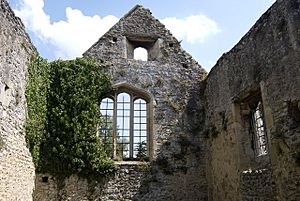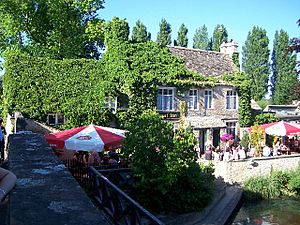Godstow facts for kids
Quick facts for kids Godstow |
|
|---|---|
 Godstow Abbey ruins |
|
| OS grid reference | SP484091 |
| District | |
| Shire county | |
| Region | |
| Country | England |
| Sovereign state | United Kingdom |
| Post town | Oxford |
| Postcode district | OX2 |
| Dialling code | 01865 |
| Police | Thames Valley |
| Fire | Oxfordshire |
| Ambulance | South Central |
| EU Parliament | South East England |
| UK Parliament |
|
Godstow is a small village, called a hamlet, located about 4 kilometers (2.5 miles) northwest of the city of Oxford in England. It sits right next to the River Thames, nestled between the villages of Wolvercote and Wytham.
Godstow is famous for the old ruins of Godstow Abbey, which was once a nunnery. You can also find a bridge that crosses the Thames here. Near the bridge is a historic pub called The Trout Inn. The area also has a weir (a small dam) and Godstow Lock, which helps boats travel along the river.
Contents
A Glimpse into Godstow's Past
Godstow Abbey, also known as Godstow Nunnery, began to be built in 1133. It was home to a group of Benedictine nuns. A famous person named Rosamund Clifford, who was a close friend of King Henry II, lived here later in her life. She passed away around 1177 when she was about 30 years old. Her burial place is somewhere on the abbey grounds, but it is now lost.
The abbey was closed down in 1539 during a time called the Dissolution of the Monasteries. This was when King Henry VIII closed many religious houses in England.
After the abbey closed, its buildings were turned into a house called Godstow House by George Owen. His family lived there until 1645. During the English Civil War, the building was badly damaged. Because of this damage, the house slowly fell apart. Local people then used its stones to build their own homes.
A stone bridge was already in place by 1692. An earlier bridge might have been the one that Royalist soldiers defended against Parliamentarians in 1644 during the Civil War. Godstow House itself was made stronger as part of Oxford's defenses during the Siege of Oxford.
Near the Thames, close to Wolvercote and Godstow, is The Trout Inn. This pub dates back to the 1600s and is very close to Godstow Bridge. The bridge you see today was built in 1792. Part of it was rebuilt again in 1892. Godstow Lock was built here in 1790 to help boats on the river.
In Victorian times, a famous writer named Charles Dodgson, also known as Lewis Carroll, often visited Godstow. He would bring Alice Liddell (the real-life inspiration for Alice in Wonderland) and her sisters for boat trips and picnics by the river.
The ruins of Godstow Abbey were even used as a background in the movie Mamma Mia! Here We Go Again. You can see them during the song "When I Kissed The Teacher".
Building Godstow Abbey
Godstow Abbey was built on what was once an island. This island was surrounded by small streams that flowed into the River Thames. The land was given to the abbey's founder, Edith de Launceline, in 1133. Edith was a widow who decided to start a community of nuns.
The abbey was built using local limestone. It was dedicated to St Mary and St John the Baptist for Benedictine nuns. The site was made larger with more land given by John of St. John. The church part of the abbey was officially opened in 1139. King Stephen was there for the ceremony.
The abbey grew even more between 1176 and 1188. King Henry II gave the abbey a lot of money and building materials. He gave £258 (which included £100 for the church), 40,000 shingles, 4,000 laths, and a large amount of wood. King Henry II showed special favor to the abbey because his close friend, Rosamund Clifford, was buried there.
In 1435, Elizabeth Felmersham became the abbess, or head nun, of Godstow. She worked hard to manage the community of nuns. After she passed away in 1446, Alice Henley became the abbess and served until 1470. Alice Henley is remembered because a "poor brother and admirer" of hers created the "English Register." This book helped the nuns understand their financial records in English. It also contained other interesting information. Today, it helps us understand how records were kept in the 15th century.
The Abbey's Closure
The last abbess of Godstow was Lady Katherine Bulkeley. She was chosen in 1535 when she was about 35 years old. Katherine was one of three nuns who became leaders of wealthy nunneries around this time. This happened with strong support from Thomas Cromwell, a powerful advisor to King Henry VIII. These abbesses had brothers who were close to Cromwell.
Katherine's brother, Sir Richard Bulkeley, was an important figure in North Wales. The Bulkeley family had a lot of influence in Anglesey. Letters from Katherine to Cromwell show that she supported changes in religious houses. She also sent him gifts. In 1535, an inspection of the monasteries said that Godstow Abbey was well-run and in good order.
However, in late 1538, Cromwell's officer, Dr John London, visited Godstow Abbey. He demanded to speak with the nuns and pressure them to leave their religious life. Lady Katherine wrote to Cromwell, saying that Dr London and his men were threatening them. She said they refused to leave until she gave up the abbey. Dr London, in turn, claimed that Lady Katherine had attacked him.
Cromwell sent a letter back supporting Lady Katherine. She then assured Cromwell that they did not follow the Pope or believe in purgatory. She also said they did not worship images or pray to dead saints. But Cromwell could not stop the process forever. It became clear that the King would close all religious houses, even well-run ones. The abbey was officially closed in November 1539. Lady Katherine received a good pension of fifty pounds a year.
What the Abbey Site Looked Like
The Godstow Abbey site had several buildings. There was a guest house for visitors and the nunnery itself. An outer area contained other buildings and lodging for a priest. There was also St Thomas's chapel, which was likely used by the Abbey's servants. The main Abbey church had cloisters, which are covered walkways, and other connected buildings.
You would enter the abbey grounds from the road that ran through the outer court. Here, there was a two-story main gatehouse. It had a large gate for carts and a smaller one next to it for people walking.
George Price Boyce, a Victorian painter, visited and painted the nunnery ruins in 1862. During the 1800s and 1900s, the ruined abbey was used to gather livestock. This happened during the yearly rounding up of animals from Port Meadow.
Rosamund Clifford's Burial
Godstow Abbey was the final resting place of Rosamund Clifford. She was known for her beauty and was a long-term close friend of King Henry II. Their relationship became known in 1174. It ended when she moved to the nunnery at Godstow in 1176, shortly before she passed away.
King Henry and the Clifford family paid for her tomb. It was placed in the choir of the convent's church at Godstow. They also gave money for the nuns to care for it. Her tomb became a popular local shrine until 1191. This was two years after King Henry's death.
Hugh of Lincoln, who was the Bishop of Lincoln, visited Godstow. He noticed Rosamund's tomb right in front of the main altar. The tomb was covered with flowers and candles. This showed that local people were still praying there. The bishop ordered her remains to be moved out of the church. Her tomb was moved to the cemetery outside the abbey church. It was next to the nuns' chapter house, where people could still visit it. However, her tomb was destroyed during the Dissolution of the Monasteries under King Henry VIII.
A German traveler named Paul Hentzner visited England around 1599. He wrote that her faded tombstone had an inscription. Part of it read: ... Adorent, Utque tibi detur requies Rosamunda precamur. This means: "Let them adore ... and we pray that rest be given to you, Rosamund."
It was followed by a clever poem: Hic jacet in tumba Rosamundi non Rosamunda Non redolet sed olet, quae redolere solet. This means: "Here in the tomb lies a rose of the world, not a pure rose; She who used to smell sweet, still smells — but not sweet."
Other Burials at Godstow
Some other people buried at Godstow Abbey include:
- Walter de Clifford (died 1190)
- Walter de Clifford (died 1221)
- Isabella de Braose
Gallery
-
Godstow Bridge near Oxford by Edward William Cooke, 1835
See also
 In Spanish: Godstow para niños
In Spanish: Godstow para niños











